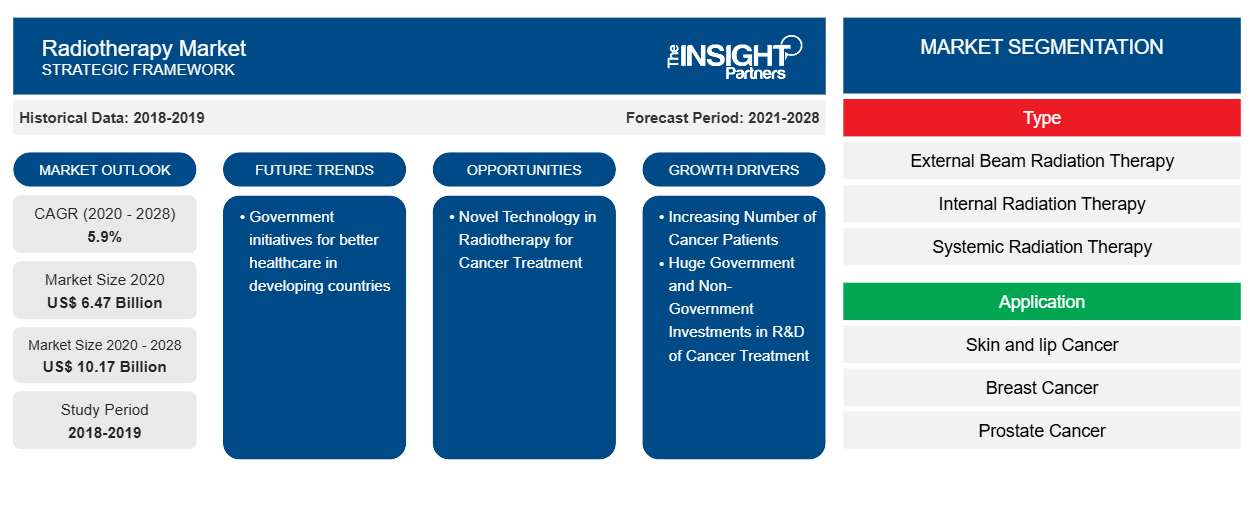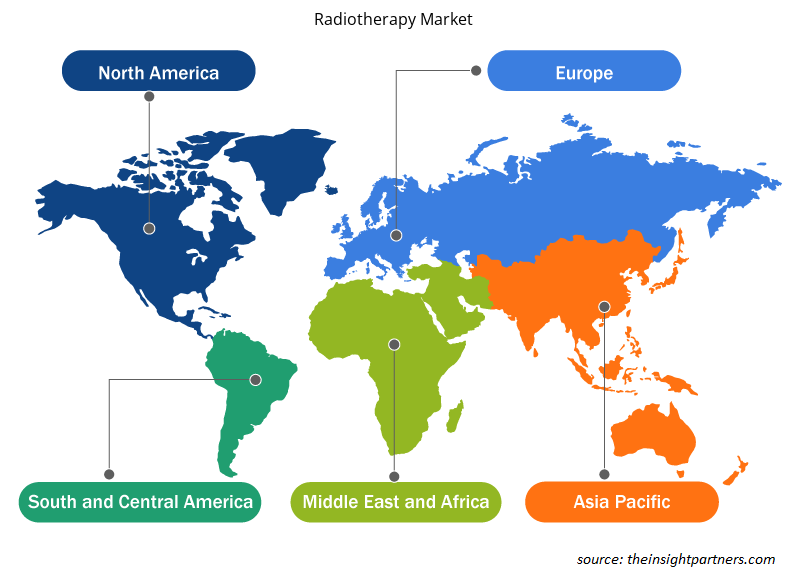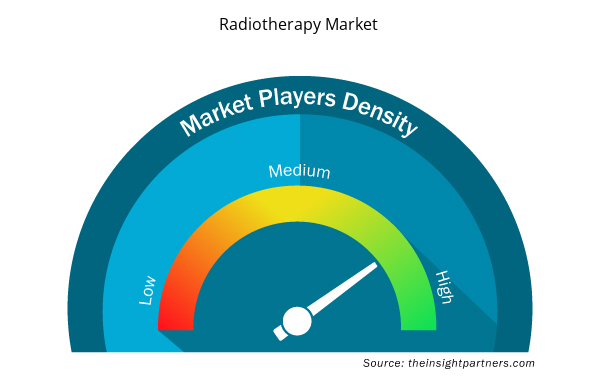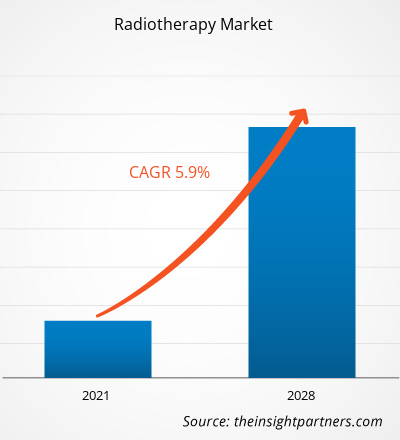[Research Report] The radiotherapy market is projected to reach US$ 10,170.80 million by 2028 from US$ 6,474.78 million in 2020; it is estimated to grow at a CAGR of 5.9% from 2021 to 2028.
Market Insights and Analyst View:
Radiotherapy, also known as radiation therapy, is a medical treatment that utilizes high-energy radiation to target and destroy malignant (cancerous) cells. It is a crucial component of cancer treatment and is employed to either cure cancer, control its growth, or alleviate symptoms. Radiotherapy often involves ionizing radiation, such as X-rays or gamma rays, to attack cancer cells and hinder their ability to grow and multiply. It can be administered externally using a machine that directs radiation toward the cancerous area (external beam radiotherapy) or internally by inserting a radioactive source within the body near the affected cells (brachytherapy). The goal of radiotherapy is to deliver precisely targeted doses of radiation to the tumor, minimizing damage to surrounding healthy tissue while maximizing its effect on cancer cells. Radiotherapy is employed in conjunction with other cancer treatments, such as surgery and chemotherapy. It is administered with careful consideration of the cancer type, its stage, and the patient's overall health. Thus, radiotherapy plays a vital role in the comprehensive management of cancer, offering an effective and localized approach to treating tumors while striving to preserve healthy tissue and improve patient outcomes.
Growth Drivers and Opportunities:
The primary drivers of the radiotherapy market's growth are the increasing cases of cancer patients, huge government and non-government investments in R&D of cancer treatment, and the growing need to reduce healthcare costs. The world is witnessing a significant rise in the number of cancer patients. According to the World Health Organization (WHO), cancer is the second leading cause of death globally, with approximately 10 million deaths reported in 2022. Among all cancer types, breast cancer is considered the most common cancer among women worldwide, and its incidence is increasing globally. Factors such as lifestyle changes, hormonal imbalances, genetic predisposition, and environmental factors contribute to the rising prevalence of breast cancer. Per the American Cancer Society, approximately 5–10% of all malignancies are caused by genes inherited from parents. Several cancer-predisposition genes have been discovered. For instance, mutations in the inherited cancer predisposition genes BRCA1 and BRCA2 raise the risk of getting certain malignancies, such as breast, ovarian, and prostate cancer.
In addition, breast cancer is one of the most common types of cancer in the US. A report published by Breastcancer.org in January 2022 stated that 1 in 8 women in the nation (or ~13%) will acquire invasive breast cancer over their lifetime. According to the same source, 287,850 new incidences of invasive breast cancer, along with 51,400 new cases of non-invasive (in situ) breast cancer, are anticipated to be detected in women in the US in 2022. In the same year, the country is anticipated to record ~2,710 additional cases of invasive breast cancer in men. Approximately 1 in 833 men might develop breast cancer in their lives. With the rise in breast cancer cases, there is an increasing need for effective and targeted therapies to improve patient outcomes. This has led to a surge in research and development activities in breast cancer therapeutics. The rising incidence of breast cancer has underscored the essential role of radiotherapy in the comprehensive treatment of this prevalent malignancy. As the number of individuals diagnosed with breast cancer continues to increase, radiotherapy stands as a critical modality within the multidisciplinary approach to cancer care. Radiotherapy plays a pivotal role in the management of breast cancer, serving various purposes, such as postsurgical treatment to eradicate residual cancer cells, neoadjuvant therapy to shrink tumors before surgery, and adjuvant therapy to reduce the risk of cancer recurrence. Additionally, radiotherapy is employed to alleviate symptoms and improve outcomes for advanced or metastatic breast cancer.
Customize This Report To Suit Your Requirement
You will get customization on any report - free of charge - including parts of this report, or country-level analysis, Excel Data pack, as well as avail great offers and discounts for start-ups & universities
Radiotherapy Market: Strategic Insights

- Get Top Key Market Trends of this report.This FREE sample will include data analysis, ranging from market trends to estimates and forecasts.
Customize This Report To Suit Your Requirement
You will get customization on any report - free of charge - including parts of this report, or country-level analysis, Excel Data pack, as well as avail great offers and discounts for start-ups & universities
Radiotherapy Market: Strategic Insights

- Get Top Key Market Trends of this report.This FREE sample will include data analysis, ranging from market trends to estimates and forecasts.
On the other hand, the lack of skilled personnel to perform radiotherapy is a significant bottleneck that constrains the growth and accessibility of radiation therapy services, particularly in regions facing healthcare workforce shortages. Skilled radiation oncologists, medical physicists, radiation therapists, and dosimetrists are essential for effectively and safely administering radiotherapy. However, a global shortage of these highly specialized professionals has limited the capacity of healthcare facilities to deliver crucial radiation treatments, leading to increased patient waiting times, suboptimal treatment access, and a strain on the healthcare system.
Consequently, the shortage of skilled personnel hampers the expansion and reach of the radiotherapy market, reducing the potential for broader adoption and utilization of radiotherapy services in various healthcare settings. The limited availability of skilled professionals impedes the capacity to provide timely and optimal radiation treatment for cancer patients. It impacts the ability of healthcare facilities to leverage advanced radiotherapy technologies and techniques fully. Additionally, multi-stakeholder collaborations, international partnerships, and the establishment of supportive frameworks for professional development are pivotal in addressing the lack of skilled personnel, enabling the expansion and efficacy of radiotherapy services, and ensuring that patients have access to the critical treatments they require.
Report Segmentation and Scope:
The “Global radiotherapy market” is segmented based on the type, application, end-user, and region. The radiotherapy market is broadly segmented into systemic, external beam, and internal radiation therapy. The radiotherapy market is classified based on applications, such as skin and lip cancer, breast cancer, prostate cancer, cervical cancer, lung cancer, and others. The end-user segment of the radiotherapy market is broadly segmented into hospitals, ambulatory and radiotherapy centers, and others. The radiotherapy market based on geography is segmented into North America (US, Canada, and Mexico), Europe (Germany, France, Italy, UK, and Rest of Europe), Asia Pacific (Australia, China, Japan, India, South Korea, and Rest of Asia Pacific), Middle East & Africa (South Africa, Saudi Arabia, UAE, and Rest of Middle East & Africa), and South & Central America (Brazil, Argentina, and Rest of South & Central America)
Segmental Analysis:
Based on the type, the radiotherapy market is segmented into external beam, internal, and systemic radiation therapy. In 2022, the radiotherapy market revenue was mostly attributed to external beam radiation therapy, which had the largest share. The global radiation treatment market is expected to grow during the forecast period due to rising cancer incidence and prevalence rates in both developed and developing nations, technical developments, and increased healthcare spending. To enhance patient outcomes, cancer centers are expanding the availability of external beam radiation therapies, including stereotactic radiosurgery, intensity-modulated radiation therapy (IMRT), and 3-D conformal radiation therapy. Healthcare firms can expand their research and development efforts in radiation therapy for cancer because of these therapy choices.
Based on the cancer segment, the radiotherapy market is segmented into skin and lip cancer, breast cancer, prostate cancer, cervical cancer, lung cancer, and others. Skin cancer, which includes squamous cell carcinoma, melanoma, and basal cell carcinoma, mostly develops in skin cells as a result of exposure to ultraviolet (UV) light. The three main causes of lip cancer are smoking, immune system compromise, and UV radiation exposure. A significant growth in the skin and lip cancer segment is anticipated throughout the projected period. Growing incidence of skin and lip cancer, substantial R&D pipelines, improvements in radiation technology, rising demand for non-invasive cancer treatments like radiotherapy, and expanding access to radiotherapy services globally are some factors propelling the segment's growth. For example, by the end of 2023, the United States will have detected 97,610 cases of melanomas, with 58,120 males and 39,490 women, according to data from the American Cancer Society in January 2023. Therefore, there will be a considerable need for radiation devices for therapeutic reasons due to the increased prevalence of skin and lip cancer, which will fuel market expansion.
Based on the end user, the radiotherapy market is classified into hospitals, ambulatory and radiotherapy centers, and others. Throughout the forecast period, the hospital segment is expected to have a significant global market share. This is explained by an increase in the number of cancer patients and an increase in the use of different radiation treatments in hospitals.
Regional Analysis:
Based on geography, the global radiotherapy market is divided into five key regions: North America, Europe, Asia Pacific, South & Central America, and Middle East & Africa.
North America is anticipated to witness notable expansion in the radiation therapy market throughout the forecast period. The rising incidence and prevalence of cancer, major companies in the area, and the introduction of innovative products all contribute to the market's expansion. The American Cancer Society's most frequent cancer among women in the US is breast cancer, according to data updated in January 2023. It represents one in three, or 30%, of all newly diagnosed female cancers in the nation each year. The same source projects that by the end of 2023, women will receive new diagnoses for 297,790 cases of invasive breast cancer and 55,720 cases of ductal carcinoma in situ (DCIS). It is expected that the cancer burden will drive the nation's need for radiation therapy. As a result, the country's high cancer incidence and prevalence necessitate the development of sophisticated radiation treatments, which is also expected to fuel the region's overall market expansion.
Furthermore, the major regional players are actively involved in several advances linked to radiotherapy, fueling the expansion of the regional market. For example, SkinCure Oncology announced in September 2021 that positive data (99.3% cure rate) for Image-Guided Superficial Radiotherapy (IGSRT) in treating squamous cell carcinoma (SCC) and basal cell carcinoma (BCC) had been obtained from a clinical trial. Furthermore, GE Healthcare presented 15 cutting-edge multi-modality radiation treatment solutions in October 2021 at the American Society for Radiation Oncology's 2021 event to enhance patient-centered care and advance precision medicine. The demand for radiotherapy in the nation is anticipated to increase due to these recent breakthroughs, propelling the expansion of the regional market as a whole.
Industry Developments and Future Opportunities:
Various initiatives taken by key players operating in the global radiotherapy market are listed below:
In May 2023, GE HealthCare launched three new products that highlight the radiation oncology care pathway, which includes Intelligent Radiation Therapy (IRT), Auto Segmentation, and an upgraded Magnetic Resonance (MR) Radiation Therapy Suite (AIR Open Coil Suite). To assist patients in leading the healthiest lives possible, each of these cutting-edge solutions—which will be on display at the European Society for Therapeutic Radiology and Oncology 2023 Congress—was created to enable physicians to deliver the highest caliber of individualized care by giving them access to the data, technologies, and diagnostics they need to make well-informed decisions.
In February 2023, RefleXion Medical received US FDA approval for SCINTIX biology-guided radiotherapy, a cutting-edge treatment for early and late-stage cancers.
Radiotherapy Market Regional Insights
The regional trends and factors influencing the Radiotherapy Market throughout the forecast period have been thoroughly explained by the analysts at Insight Partners. This section also discusses Radiotherapy Market segments and geography across North America, Europe, Asia Pacific, Middle East and Africa, and South and Central America.

- Get the Regional Specific Data for Radiotherapy Market
Radiotherapy Market Report Scope
| Report Attribute | Details |
|---|---|
| Market size in 2020 | US$ 6.47 Billion |
| Market Size by 2028 | US$ 10.17 Billion |
| Global CAGR (2020 - 2028) | 5.9% |
| Historical Data | 2018-2019 |
| Forecast period | 2021-2028 |
| Segments Covered |
By Type
|
| Regions and Countries Covered | North America
|
| Market leaders and key company profiles |
Radiotherapy Market Players Density: Understanding Its Impact on Business Dynamics
The Radiotherapy Market market is growing rapidly, driven by increasing end-user demand due to factors such as evolving consumer preferences, technological advancements, and greater awareness of the product's benefits. As demand rises, businesses are expanding their offerings, innovating to meet consumer needs, and capitalizing on emerging trends, which further fuels market growth.
Market players density refers to the distribution of firms or companies operating within a particular market or industry. It indicates how many competitors (market players) are present in a given market space relative to its size or total market value.
Major Companies operating in the Radiotherapy Market are:
- Siemens Healthineers AG
- Accuray Incorporated
- Sumitomo Heavy Industries, Ltd.
- Elekta AB
- Hitachi, Ltd.
Disclaimer: The companies listed above are not ranked in any particular order.

- Get the Radiotherapy Market top key players overview
Competitive Landscape and Key Companies:
Some of the prominent players operating in the global radiotherapy market are GE Healthcare, GE Healthcare, Elekta, ViewRay Technologies, Inc., Accuray Incorporated, Isoray Inc., Hitachi, Ltd., ALCEN (PMB), Siemens Healthineers AG, and amongst others. These radiotherapy markets focus on new product launches and geographical expansions to meet the growing consumer demand worldwide and increase their product range in specialty portfolios. They have a widespread global presence, allowing them to serve many customers and subsequently increase their market share. The report offers radiotherapy market trends analysis emphasizing various parameters such as technological advancements, market dynamics, and competitive landscape analysis of leading global market players.
- Historical Analysis (2 Years), Base Year, Forecast (7 Years) with CAGR
- PEST and SWOT Analysis
- Market Size Value / Volume - Global, Regional, Country
- Industry and Competitive Landscape
- Excel Dataset


- Airport Runway FOD Detection Systems Market
- Educational Furniture Market
- Electronic Data Interchange Market
- Unit Heater Market
- Parking Management Market
- Medical and Research Grade Collagen Market
- Artificial Intelligence in Healthcare Diagnosis Market
- Hydrocephalus Shunts Market
- Fishing Equipment Market
- Gas Engine Market

Report Coverage
Revenue forecast, Company Analysis, Industry landscape, Growth factors, and Trends

Segment Covered
Type, Product, Application, and End User, and Geography

Regional Scope
North America, Europe, Asia Pacific, Middle East & Africa, South & Central America

Country Scope
Argentina, Australia, Brazil, Canada, China, France, Germany, India, Italy, Japan, Mexico, Saudi Arabia, South Africa, South Korea, Spain, United Arab Emirates, United Kingdom, United States
Frequently Asked Questions
Radiotherapy is majorly used to control the growth of a tumor while restricting the harm to nearby normal and healthy tissue. Radiotherapy uses high-energy radiation, generally x-rays, to destroy the cancer cells and treat tumors in the prostate, breast, head & neck, lung, and any other parts in the body where radiation treatment is indicated.
The growth of the market is attributed to a few key driving factors such as increasing prevalence of cancer and rising number of conferences and symposiums to boost the awareness about radiation therapy. However, increased risk of adverse effects due to radiation therapy restrains the market growth.
The radiotherapy market majorly consists of the players such as Siemens Healthineers AG, Accuray Incorporated, Sumitomo Heavy Industries, Ltd., Elekta AB, Hitachi, Ltd., Koninklijke Philips N.V., Brainlab AG, PROTOM INTERNATIONAL, Varian Medical Systems, Inc., Maastro, and Mevion Medical Systems amongst others.
Trends and growth analysis reports related to Life Sciences : READ MORE..
The List of Companies - Radiotherapy Market
- Siemens Healthineers AG
- Accuray Incorporated
- Sumitomo Heavy Industries, Ltd.
- Elekta AB
- Hitachi, Ltd.
- Koninklijke Philips N.V.
- Brainlab AG
- PROTOM INTERNATIONAL
- Varian Medical Systems, Inc.
- Maastro
- Mevion Medical Systems

 Get Free Sample For
Get Free Sample For